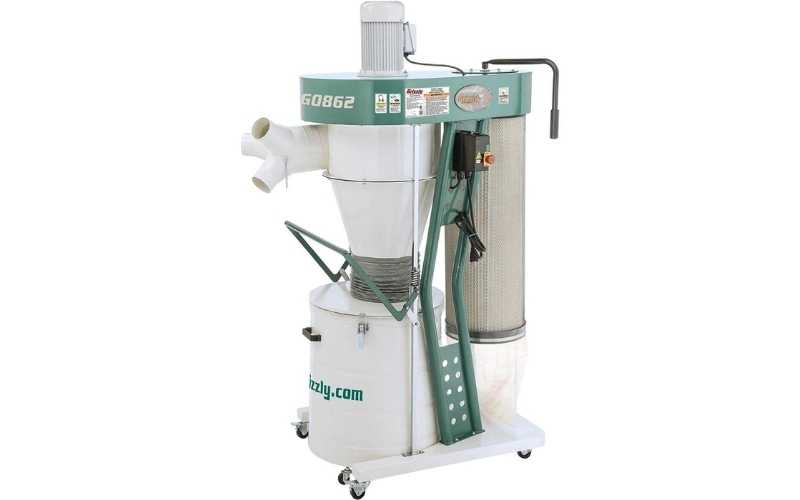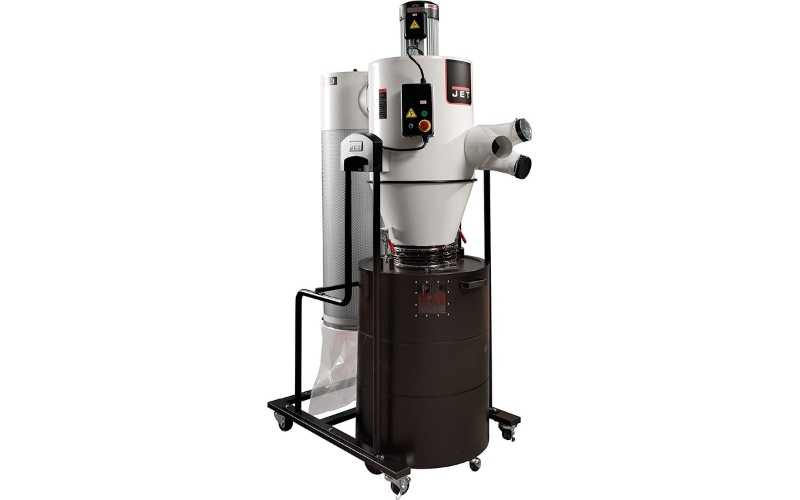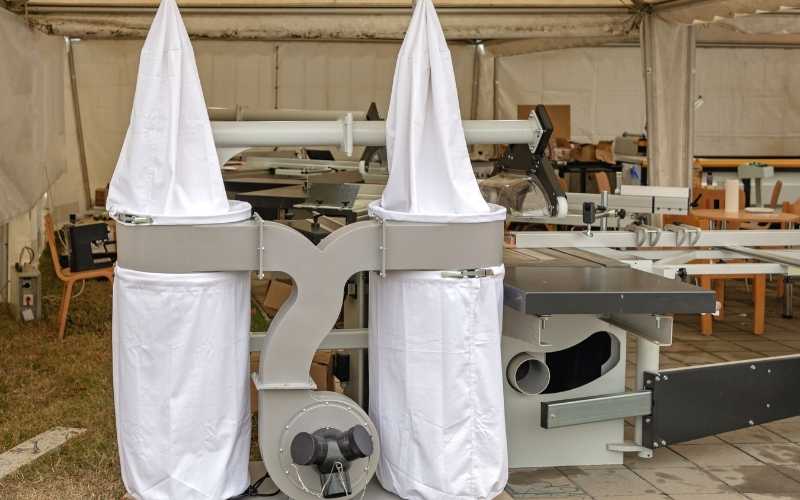Sawdust is one of the most abundant material in any woodworking shop, and even though it has its uses, if not adequately controlled and collected, it can quickly become a nuisance and danger to health in the workshop.
That is why dust collection is very important when carrying out woodworking projects. Any project that involves sawing, drilling, routing, planing and sanding of wood produces a lot of sawdust.
To keep your workshop clean and in good condition, and to avoid breathing in this fine sawdust particles, you should have a good dust collection system running in your workshop.
Here in this article, I’m going to explain the different methods, equipment and tools you need to properly collect and discard sawdust from your workshop. I’m also going to help you choose the most affordable option so you don’t go on spending too much on expensive dust collection system and ductwork.
Table of Contents
Types of Dust Collection System
First of all, dust collecting equipment can be broken down into 2 main categories which include:
Shop vacs / Extractors and larger dust collectors like the unit shown below.

It’s very important that you know the differences between the two categories so that you can choose the right one for your projects.
The one you choose is going to depend on the machines and tools you operate, the size of your workshop and your budget.
So, what are the differences between shop vacs / extractors and large dust collector machines?
Well, the main difference between them is expressed in a term called CFM which means Cubic Feet Per Minute.
This stands for the volume of air the shop vac, extractor or dust collector moves per minute. The more volume of air the equipment moves, the more dust is collected or extracted from your workshop.
Shop vacs and extractors usually have low CFM. Which means they move a low volume of air at a high pressure. As a result they are usually equipped with smaller hoses which are more effective when the hose is closer to the sawdust.
On the other hand, large dust collectors have higher CFM. Which means they move a higher volume of air at lower pressures. As a result they come equipped with larger hoses which move far more sawdust even when the hose is not very close to the source of the sawdust.

Shop vacs and extractors are relatively inexpensive usually in the price range of 60 to 700 bucks. Large dust collectors on the other hand come with large initial costs with prices ranging from 2000 up to 10,000 bucks.
That is not the only cost associated with owning a large 4 to 6 horsepower dust collector. You also have to pay for ductwork, which is a series of pipes that connects the dust collector to the different tools in your workshop like your table saw, planer, sander, your jointer and so on.
This ductwork does not come cheap as well. Depending on the size of your shop, the materials needed can cost up to a thousand bucks or more.
With your dust collector and ductwork pipes couplings ready, you still have to pay for a professional to install it for you, unless you know how it’s done.
All this adds up very quickly, thus making it very expensive to own and use a large dust collector in the workshop.
I’m not saying all this to discourage you from buying it in your workshop, but to help you know the associated cost and the amount of work required for installation before it starts working.
Shop vacs and extractors don’t require any installation. They’re just plug and play, and they’re very portable, which means you can even use them outside your workshop, on the jobsite and so on.
Large 4+ hp dust collectors on the other hand are very large and quite heavy, takes up a lot of space and are not mobile. Once they’re installed, it’s permanent unless you’re changing workshops. This makes them not ideal for the average hobbyist with a small or non-existent workshop space.
However, if you have a proper workshop with large equipment like floor model table saws, planers, jointers, sanders and more that produce lots of dust, having a large dust collector is strongly recommended.
Principles of Dust Collection
Exposure to fine dust particles during woodworking projects can cause adverse health effects on the individual. That is why it’s very important to know the principles and fundamentals of dust collection, and use appropriate equipment when carrying out your projects.
Here are 5 fundamental principles you should know if you want to keep a dust-free working environment in your workshop.
Wear a Nose Mask

No matter how good your dust collection system is, it probably not going to collect 100 percent of the dust produced while carrying out your projects.
Your last line of defense is a nose mask. Using a suitable fitting nose mask can help you avoid breathing in the remaining percentage of dust left in the air in your workshop.
Wearing a nose mask is very essential, especially if you don’t have good dust collection in place already. For instance when you’re working outdoors or on the jobsite.
The most important thing to make sure of when using a nose mask is that you ensure it fits you. There should be no leakages at the side of your nose. If there’re any leaks, then the purpose of wearing it is defeated.
So make sure to find a nose mask that fits your nose and mouth area properly without any leaks, so it can keep out the dust in the surrounding air.
Collect Dust at the Source
This is one of the most crucial part of dust collection in the workshop. The suction hose should not be far off from the source of dust emission. Instead, it should be positioned as close as possible to the source, so that the dust and chips gets picked up as soon as they’re generated.
That means the suction tube should be as close as possible to the blade of your table saw, miter saw, bandsaw and so on. It should be very close to the cutterhead of your planer, jointer, and the sanding disk of your sander, to ensure efficient dust collection.
If it’s not collected at the source, then it will find its way into the workshop air, being breath in and settling on tools and machines around.
Prioritize CFM or Air Volume
As already mentioned above, the more air volume or CFM your dust collection system is able to move, the more efficient it will be able to capture dust from your tools and machinery.
The CFM requirements of most shop machinery like table saws, planers and grinders range between 300 and 1000.
Therefore, ensure to put all this into consideration when choosing a dust collection system and laying ductwork for your workshop. For your ductwork, ensure the hoses used are large enough in diameter and laid out properly to ensure efficient airflow through the system.
Install a Cyclone Separator

The main reason for using a cyclone separator is to prevent the bulk of the dust like chips and larger dust particles from getting to your filter.
Allowing these wood chips and larger dust particles to get to the filter means the filter will clog up quickly and reduce the airflow at the source, thus allowing escape of dust into the surrounding air.
Apart from that, a clogged filter means you have to change your filter constantly, adding additional running costs which you should avoid at all cost.
Installing the cyclone separator and allowing the sawdust to pass through it first will ensure the bulk of the sawdust will never find its way to your filter, thus prolonging its life and ensuring the whole system runs smoothly without interruption or downtime.
A good cyclone separator can prevent 99 percent of the dust produced at the source from getting to your filter. Which means only the fine minute dust particles find their way there.
Use a HEPA Certified Filter
HEPA is an acronym that stands for high efficiency particulate air. This is used by the U.S. Department of Energy to describe a mechanical filter that is able to remove 99.97 percent of dust, mold, bacteria, pollen and other airborne particles that are 0.3 microns in size.
The cyclone separator mentioned above does not collect 100 percent of the dust produced at the source. Using this HEPA filter in your dust collector will help trap the minute dust particles that go through the cyclone separator to ensure the air in your shop is clean.

